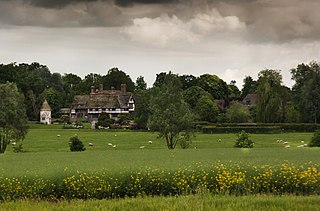Related Research Articles

Charles Christopher Pepys, 1st Earl of Cottenham, was an English lawyer, judge and politician. He was twice Lord High Chancellor of Great Britain.

Sir Thomas Wyatt the Younger was an English politician and rebel leader during the reign of Queen Mary I; his rising is traditionally called "Wyatt's rebellion". He was the son of the English poet and ambassador Sir Thomas Wyatt.

The River Eden is a tributary of the River Medway in south east England. It rises at the foot of the North Downs escarpment near Titsey in Surrey and runs initially southwards through Oxted before turning eastwards to enter Kent. After flowing through Edenbridge and passing Hever Castle, the Eden meets the Medway at Penshurst.
Andrew Windsor, 1st Baron WindsorKB (1467–1543), was a Member of Parliament, English peer, and Keeper of the Wardrobe, knight banneret and military commander.
William Strachey was an English writer whose works are among the primary sources for the early history of the English colonisation of North America. He is best remembered today as the eye-witness reporter of the 1609 shipwreck on the uninhabited island of Bermuda of the colonial ship Sea Venture, which was caught in a hurricane while sailing to Virginia. The survivors eventually reached Virginia after building two small ships during the ten months they spent on the island. His account of the incident and of the Virginia colony is thought by most Shakespearean scholars to have been a source for Shakespeare's play The Tempest.
Sir Anthony Kingston was an English royal official, holder of various positions under several Tudor monarchs.

Tandridge is a village and civil parish in the Tandridge District, in the county of Surrey, England. Its nucleus is on a rise of the Greensand Ridge between Oxted and Godstone. It includes, towards its middle one named sub-locality (hamlet), Crowhurst Lane End. In 2011 the parish had a population of 663 and the district had a population of 82,998.

Crowhurst is a civil parish and dispersed village in a rural part of the Tandridge district of Surrey, England. The nearest town is Oxted, 3 miles (5 km) north. Rated two architectural categories higher than the medieval church is the Renaissance manor, Crowhurst Place, which is a Grade I listed building.
Anne Bourchier was the suo jure7th Baroness Bourchier, suo jureLady Lovayne, and Baroness Parr of Kendal. She was the first wife of William Parr, 1st Marquess of Northampton, Earl of Essex, and the sister-in-law of Catherine Parr, the sixth wife of Henry VIII of England.

Sir William Kingston, KG was an English courtier, soldier and administrator. He was the Constable of the Tower of London during much of the reign of Henry VIII. Among the notable prisoners he was responsible for were Queen Anne Boleyn, as well as the men accused of adultery with her. He was MP for Gloucestershire in 1529 and 1539.

Anne Gainsford, Lady Zouche was a close friend and lady-in-waiting to Queen consort Anne Boleyn.
George Abraham Crawley (1864–1926) was a British artist, designer and purveyor of English taste. His best known works include Crowhurst Place and Old Surrey Hall, both in Surrey, England, and the design of Westbury House, at Old Westbury Gardens, in Long Island, New York, for John Shaffer Phipps.

Sir John Hippisley was an English privateer and politician who sat in the House of Commons at various times between 1621 and 1653. He supported the Parliamentary cause in the English Civil War.
Sir George Harper, JP was an English politician. He was Member of Parliament for Kent.

Sir William Courtenay"The Great", of Powderham in Devon, was a leading member of the Devon gentry and a courtier of King Henry VIII having been from September 1512 one of the king's Esquires of the Body. He served as Sheriff of Devon three times: from February to November 1522, 1525/26, and 1533/34. He was elected Knight of the Shire for Devon in 1529.
Sir John Shaa or Shaw was a London goldsmith. He served as engraver and later joint Master of the Mint, and as Sheriff and Lord Mayor of London. While Lord Mayor he entertained ambassadors from Scotland, and was among those who welcomed Catherine of Aragon to England. He is mentioned in a poem by William Dunbar.
George Carleton was a lawyer, landowner and Member of Parliament with strong Puritan sympathies. It has been suggested that he was the secret author of the Marprelate tracts, and both he and his third wife were prosecuted for their involvement in the Marprelate controversy. Ordered to appear daily before the Privy Council in April 1589, he died in early 1590 before a decision in the proceedings against him had been reached.
Anthony Carleton was a landowner and Member of Parliament, and the father of Dudley Carleton, 1st Viscount Dorchester.
Nicholas Gainsford, also written Gaynesford or Gaynesforde, of Carshalton, Surrey, of an armigerous gentry family established at Crowhurst, was a Justice of the Peace, several times Member of Parliament and High Sheriff of Surrey and Sussex, Constable and Keeper of Odiham Castle and Park, Hampshire, who served in the royal households from around 1461 until his death in 1498. Rising to high office during the reign of Henry VI, he was an Usher to the Chamber of Edward IV and, by 1476, to his queen Elizabeth Woodville. Closely within the sphere of Woodville patronage, he was a favourer of Edward V, and was a leader in the Kentish rising of 1483 against Richard III. He was attainted in 1483, but was soon afterwards pardoned, and fully regained his position and estate as Esquire to Henry VII and Elizabeth of York after the Battle of Bosworth Field. He established the Carshalton branch of the Gainsford family.

Crowhurst Place, Crowhurst, Surrey, England is a medieval hall house dating from the early 15th century. In the 20th century, the house was reconstructed and enlarged by George A. Crawley, firstly for himself and subsequently for Consuelo Vanderbilt, Duchess of Marlborough. It is a Grade I listed building.